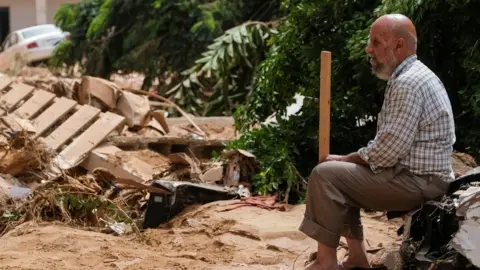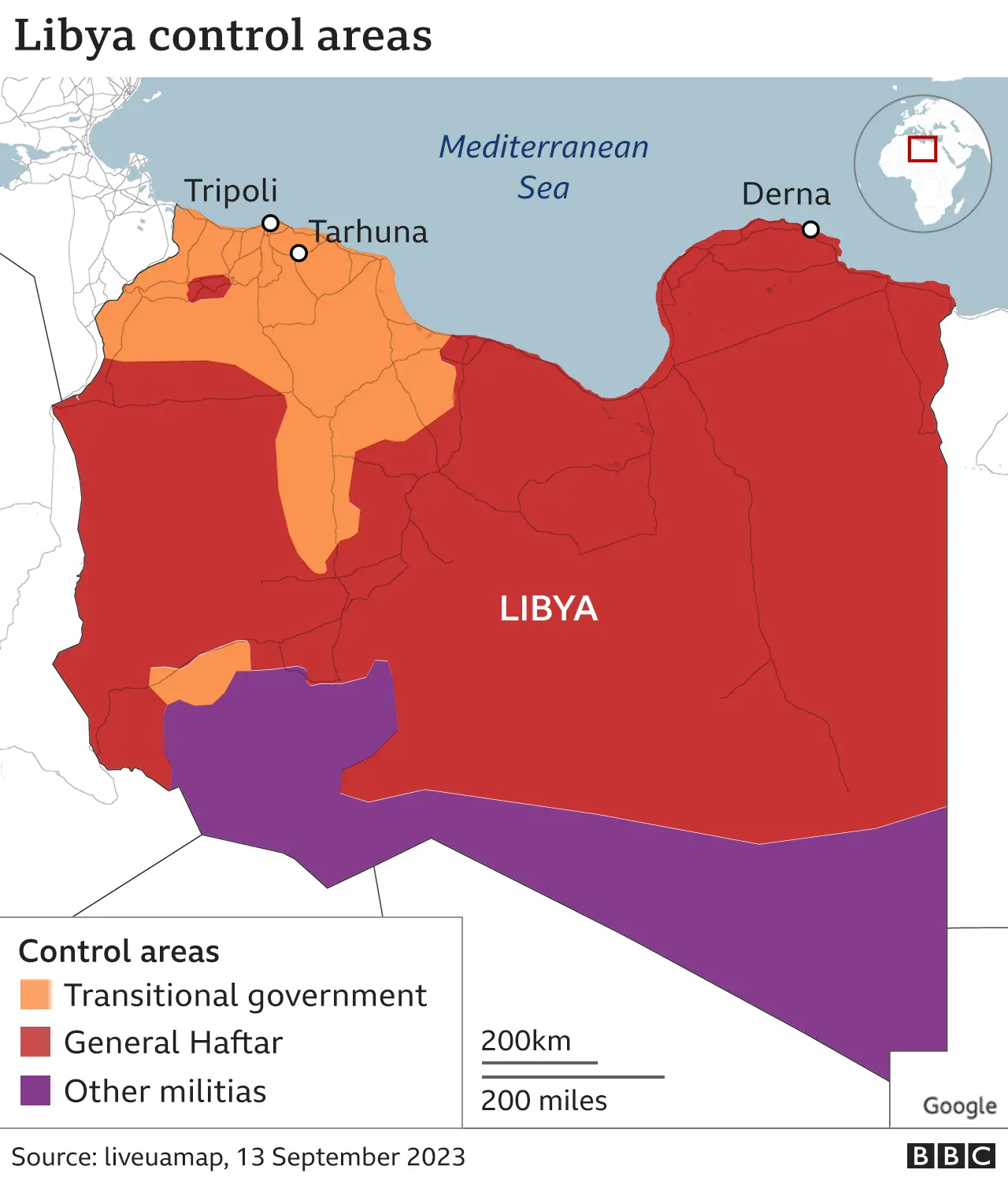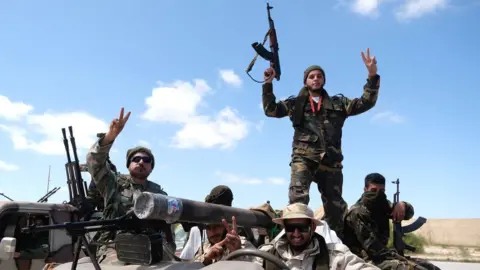Libya turmoil made Derna flooding even more deadly
 Reuters
ReutersUp to 20,000 people are feared to have died after raging floods swept through eastern Libya.
The North African country is experiencing a "calamity of epic proportions", the UN has said, but did things have to be this way?
Once one of Africa's most prosperous countries, years of lawlessness have left it a fragile, divided state - ill-prepared to cope with the forces unleashed by a natural disaster.
The vast majority of deaths from the flooding have occurred in Derna - a city emblematic of Libya's breakdown. It has received little investment for decades and a government minister in the area admitted that one of the dams that burst had not been maintained "for a while".
One country, two governments
Libya has been beset by chaos since forces backed by the West's Nato military alliance overthrew long-serving ruler Col Muammar Gaddafi in October 2011.
The oil-rich country once had one of the highest standards of living in Africa, with free healthcare and free education, although Gaddafi ran a ruthless regime that had little time for critics.
Since the fall of Gaddafi, Libya has been split between two rival governments and mired in conflict between numerous different militias.
Prime Minister Abdul Hamid Dbeibah leads the UN-backed Government of National Unity in the Tripoli, Libya's western capital city.
Mr Dbeibah took office in 2021 as part of a UN-brokered deal which was supposed to lead to elections within months. However, these have not yet been held amid squabbling by the rival politicians.

A rival administration, known as the House of Representatives, is in charge of eastern Libya, which includes the areas worst affected by the floods. It also controls many southern areas, which are mostly uninhabited desert.
Osama Hamad is the prime minister in the east, based in the port city of Tobruk, 1,000km (620 miles) from Tripoli.
However, many feel power there is really held by military strongman Gen Khalifa Haftar, who leads a powerful militia called the Libyan National Army, and is allied with Egypt, the UAE and Russia.
What impact has this lawlessness had?
Until 2020, there was all-out warfare between the two sides, with Gen Haftar's forces trying to seize Tripoli before being thwarted with the help of Turkey.
 Reuters
ReutersArmed groups supporting the rival governments built local power bases and seized economic assets. Despite a ceasefire three years ago, skirmishes still erupt between these factions.
These tensions have impacted civilians - around 135,000 Libyans have been forced from their homes and over 800,000 are in need of humanitarian aid, according to UN data from 2021.
Additionally, the cost of living is high, medicines are in short supply and infrastructure is crumbling.
One eastern official admitted that one of the dams which burst in Derna on Sunday had been neglected.
"We are handling the situation, but do not have a complete capacity," Hisham Chkiouat, aviation minister and emergency committee member for the Tobruk government, told BBC Newshour.
"The dam that collapsed hasn't been maintained for a while."
How politics made Libya vulnerable to natural disaster
Having two feuding governments makes it difficult to respond to disasters in a swift, co-ordinated manner.
At the outset of the Covid-19 pandemic, Libya's administrations made their own plans before a national health department stepped in and took a more cohesive approach.
And as Storm Daniel, which caused the recent flooding, made its way to Libya, each government announced separate precautionary measures.
The complications don't stop there - countries that would like to send support to Libya following the flooding have had issues negotiating with the two administrations.
But despite the split, the government in Tripoli has sent a plane with 14 tonnes of medical supplies, body bags and more than 80 doctors and paramedics to the east.
Optimists wonder if this sign of co-operation could push the politicians to finally put their differences aside and form a single government once more.
Joint efforts are rare, but not unheard of. In July, the administrations agreed to form a committee to oversee the sharing of oil revenues. Libya's oil sector is central to the economy, but has been disrupted by violence since Gaddafi's fall.
Derna - a neglected city
When Storm Daniel swept into the eastern city of Derma, intense rains burst two dams and huge amounts of water raced towards the sea, sweeping away the houses in its path.
Derna's mayor estimates that between 18,000 and 20,000 people were killed by the floods.
Decades of neglect contributed to this devastation, Dr Hani Shennib, president of the National Council of US Libya relations told the BBC's Newsday programme.
"Derna is one city that was constantly defiant to Gaddafi so he punished it very badly," said Dr Shennib, who has relatives missing in Derna.
"The city eroded progressively - no schools and the hospitals that were in very poor condition, neglected infrastructure... unfortunately that continued after the revolution."
When Storm Daniel made landfall, Derna, a city of tens of thousands, did not have a single, official hospital, Dr Shennib said. Instead, a five-bedroom villa had been serving as a makeshift hospital.
"What we're seeing is really sad because yes we know that there are natural disasters, but there is a huge component of human negligence... there is an incredible amount of self-destruction that's happening in Libya," he said.
